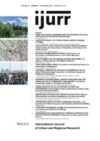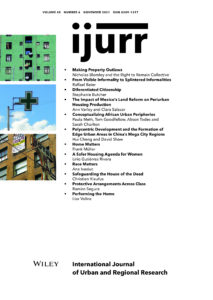Volume 45 Issue 6 November 2021
In This Issue...
Articles
Thinking about urban spaces and the practices associated with them–for their production, use, appropriation, or transformation–usually leads to their naming and categorization. This is not necessarily done with evil intentions and might indeed be helpful–even necessary–for conceptualization and theorization. The risk remains, however, that the naming and categorization of spaces and spatial practices become stigmatizing and debilitating, especially when they assume regulatory or disciplinary functions. The articles in the November issue of IJURR tackle this issue with examples from a broad geographical range. They challenge dichotomous understandings of formality and informality by showing how the formal and the informal can be intertwined; they show how urban spaces stigmatized as ‘outlaw areas’ are in fact produced by law; they urge us to rethink our understanding of polycentricity, peripherality, formality, informality, and citizenship in the light of diverse practices and power relations that mark everyday urban life. The articles in this issue remind us, in short, that it is a good idea to regularly revisit namings and categorizations of urban spaces and the practices associated with them, lest they become moribund, unhelpful, or perilous labels.
— Mustafa Dikeç
Interventions
The six essays in November’s Interventions collection help deepen our understandings of peripheral urbanism with a focus on the material forms and political practices deployed to secure one’s home from threats ranging from property theft to state violence. Guest edited and elegantly framed by Frank Müller, “Housing Matters: The Material Cultures of Urban Security” shifts our attention from the more traditional focus on the neighborhood or the gated enclave to the house as a site of urban security production. With rich empirical cases drawn from research in Medellin, suburban Rome, Lima, LaPlata, and Jerusalem, the house is revealed to be a site in need of protection; a site of political engagement; and a site from which community is forged along and against the lines of class, gender, and race.
After Müller’s insightful introduction that brings a focus on material culture into critical security studies, Lirio Gutiérrez Rivera’s essay centers us in Medellin, where she draws our attention to the role of women’s grassroots movements and helps us see the house as a site of women’s knowledge, relationships, and experiences. Ana Ivasiuc’s essay, drawn from research in suburban Rome, focuses on familiar divisions of class and race in urban security and the specter of the racialized other so central to the production of ‘domestic fortresses.’ Christien Klaufus insightfully situates us in cemetery spaces in Lima where the protection of houses of the living and dead converge. Ramiro Segura draws our attention back to contrast between security at the scale of the house and the scale of the neighborhood in LaPlata, Argentine. In LaPlata, we see how the work performed by gates at the scale of the neighborhood for upper middleclass households is enacted by fences and dogs for the city’s poorer residents. And lastly, Lior Volinz’s essay reveals that claims-making by Palestinian Jerusalemites entails the curation of the home and the showcasing of its interior spaces to state authority. Together, this rich collection and these five detailed vignettes help situate the house in understandings of urban security as a material-political practice.
— Liza Weinstein
Articles
Making Property Outlaws: Law and Relegation
Published online on Sep 28th, 2021 | DOI: 10.1111/1468-2427.13031 (p 911-929)
From Visible Informality to Splintered Informalities: Reflections on the Production of ‘Formality’ in a Moroccan Housing Programme
Published online on Apr 6th, 2021 | DOI: 10.1111/1468-2427.13001 (p 930-947)
Differentiated Citizenship: The Everyday Politics of the Urban Poor in Kathmandu, Nepal
Published online on Mar 4th, 2021 | DOI: 10.1111/1468-2427.13003 (p 948-963)
The Impact of Mexico’s Land Reform on Periurban Housing Production: Neoliberal or Neocorporatist?
Published online on Jan 20th, 2021 | DOI: 10.1111/1468-2427.12999 (p 964-984)
Conceptualizing African Urban Peripheries
Published online on Oct 15th, 2021 | DOI: 10.1111/1468-2427.13044 (p 985-1007)
Polycentric Development and the Formation of Edge Urban Areas in China’s Mega City Regions: Case Study of Nansha, Guangzhou
Published online on Oct 19th, 2021 | DOI: 10.1111/1468-2427.13045 (p 1009-1027)
Interventions
Home Matters: The Material Culture of Urban Security
Published online on Jul 13th, 2020 | DOI: 10.1111/1468-2427.12879 (p 1028-1037)
A Safer Housing Agenda for Women: Local Urban Planning Knowledge and Women’s Grassroots Movements in Medellín, Colombia
Published online on Jul 13th, 2020 | DOI: 10.1111/1468-2427.12892 (p 1038-1046)
Race Matters: The Materiality of Domopolitics in the Peripheries of Rome
Published online on Jul 13th, 2020 | DOI: 10.1111/1468-2427.12891 (p 1047-1055)
Safeguarding the House of the Dead: Configurations of Risk and Protection in the Urban Cemetery
Published online on Jul 13th, 2020 | DOI: 10.1111/1468-2427.12890 (p 1056-1063)
Protective Arrangements Across Class: Understanding Social Segregation in La Plata, Argentina
Published online on Jul 13th, 2020 | DOI: 10.1111/1468-2427.12889 (p 1064-1072)
Performing the Home: Enacting Citizenship and Countering Jerusalem’s Residency Revocation Policy
Published online on Jul 13th, 2020 | DOI: 10.1111/1468-2427.12888 (p 1073-1080)
Book Reviews
Aaron Shapiro 2020: Design, Control, Predict: Logistical Governance in the Smart City. Minneapolis, MN: Minnesota University Press
Published online on Nov 1st, 2021 | DOI: 10.1111/1468-2427.13069 (p 1081-1082)
Miguel À. Martínez 2020: Squatters in the Capitalist City: Housing, Justice, and Urban Politics. New York, NY: Routledge
Published online on Nov 1st, 2021 | DOI: 10.1111/1468-2427.13070 (p 1082-1084)
Laurent Fourchard 2021: Classify, Exclude, Police: Urban Lives in South Africa and Nigeria. Oxford: Wiley Blackwell
Published online on Nov 1st, 2021 | DOI: 10.1111/1468-2427.13071 (p 1084-1085)
Lisa Björkman (ed.) 2021: Bombay Brokers. Durham, NC: Duke University Press
Published online on Nov 1st, 2021 | DOI: 10.1111/1468-2427.13072 (p 1085-1087)
Sara Fregonese 2019: War and the City: Urban Geopolitics in Lebanon. London: I.B. Tauris
Published online on Nov 1st, 2021 | DOI: 10.1111/1468-2427.13073 (p 1087-1088)
Issues in this volume
July 2021
September 2021
November 2021
March 2021
May 2021
January 2021

